Roasted Root Vegetables with Honey-Dijon Drizzle
~ Oven-roasting adds so much depth of flavor to sweet carrots, nutty parsnips and fluffy red potatoes … plus those yummy, toasty brown edges! Fantastic on their own – and even more addictive with a little Honey-Dijon Drizzle to bring all the flavors together! Our Roasted Root Vegetables recipe is a delicious, easy (mix it right on the sheet pan!) side dish any night. And it’s especially perfect alongside Thanksgiving turkey, Christmas roast, and Easter ham! ~
This Recipe Is: • Ready in 30 Minutes or Less • Includes Make-Ahead Steps • Vegetarian • Gluten Free •
A lot of my recipes come about simply because I’m daydreaming about what I want to eat. (I spend a ridiculous amount of time thinking about that.)
This recipe is one of those daydreams. One that I tossed together on a whim because I conjured up a vision of how great it would taste (spoiler alert: I was right!). No doubt, it’s got a lot going for it:
- Homey, comforting root vegetables with a delicious range of flavors – sweet carrots, earthy and nutty parsnips, and simply perfect potatoes
- All deliciously caramelized, with soft interiors and browned, toasty, slightly crisped exteriors
- Highlighted with a big punch of flavor from a drizzle that melds sweet honey, tangy cider vinegar, and savory-spicy dijon mustard
Mmmmmm … so much flavor from such a quick, simple side dish!
From the first time I made these Roasted Root Vegetables, my family loved the recipe as much as I did – both the plain roasted veggies they kept plucking right off the baking sheet before dinner, and the final dish, all drizzled in its yummy Honey-Dijon glory. Instant success!
Ty immediately requested that I make it again SOON. Ummmm … ok! No problem! I mean, it’s:
- super easy
- and super nutritious
So, yeah – I’m happy to make it as often as they want to eat it!
And even though it’s so very easy to make, you know I’ve got a few little tips and hints to help you along the way. Let’s start with something a lot of you may be wondering … let’s talk about those parsnips …
What Are Parsnips … and What Do Parsnips Taste Like?
Although this recipe started out from a hungry foodie’s daydream, it wasn’t a wacky-crazy daydream. Just a simple, yummy one. So, I definitely feel like most of the ingredients in this recipe are incredibly familiar and straight-forward. Potatoes … carrots … mustard … honey. Nothing much that’s surprising there. You’re all-in so far, right?
But some of you (especially my fellow Americans) may be a little less sure about those parsnips. Trust me – they’re worth a try!
Parsnips look a lot like beige carrots. They’re root vegetables that are closely related to both carrots and parsley. (Heads-up, food nerds: You can read more about parsnips’ lineage and history here.)
And what about parsnip nutrition? Parsnips are high in both soluble and insoluble fiber, folate, vitamins C and K, plus a host of other micronutrients and antioxidants. I’ve read, however, that many of the nutrients in parsnips (and even a lot of the flavor, too) are located just below the skin. So if you choose to peel your parsnips (as I personally choose to do in this recipe), it’s best to just lightly peel them, to retain more of the nutrients.
Ok ok … but you’re still wondering how they taste! Imagine a carrot that’s just slightly sweet but also a little nutty and earthy. I’d personally describe them as having some of the best “comfort food” qualities of their carrot-cousins, with a milder flavor that’s the perfect bridge between the potatoes and carrots in this recipe.
Can’t Find Parsnips?
Or maybe you’ve got a veggie-suspicious kiddo and you want to stick with well-known suspects like carrots and potatoes?
No problem!
I would simply double the amount of carrots. Or you could use a little more of both the carrots and the potatoes, to make up for the parsnips you’re leaving out.
But really … pinky-promise you’ll give parsnips a try the next time you can find them. Although they’re somewhat similar in flavor to carrots, they’re different enough to add an entirely scrumptious, additional layer of flavor that’s too good to miss here.
Ok – so now let’s do a quick walk-through of how this recipe comes together …
How Do You Make Roasted Root Vegetables?
Step #1 – Prep
Peel the carrots and (if you’re choosing to peel them) lightly peel – or even just lightly scrape – the parsnips. (Don’t peel the red potatoes.) Then chop all your veggies into about 1/2″ cubes.
You don’t have to absolutely obsess about the exact size of each piece. No need to whip out a ruler, although … ahem … I have to admit that I sometimes do.
The important thing is that the pieces are all relatively similar in size. As I mentioned in our recipe for Easy Roasted Potatoes, if you have some large chunks along with some very small bits, they won’t roast evenly at all. Instead, you’ll end up with small pieces that are burned and way overcooked, along with larger chunks that are still a little raw (#notyummy).
Step #2 – Season and Toss
Toss the veggies with olive oil, salt and pepper. You can do this in a bowl, or (shortcut alert!) just do it right on your parchment-lined baking sheet (your hands are your best tool here).
Either way, be sure that all the veggie pieces are evenly coated with oil. And you want the salt and pepper evenly distributed throughout the vegetables, not all glommed onto a few pieces.
Step #3 – Spread ’em Out
Spread the veggies out on your baking sheet so they’ve got a little bit of space and aren’t piled on top of each other.
I’ve mentioned this lots of times before (like in our recipes for Oven Roasted Carrots, Cheesy Oven-Baked Pizza Fries and Parmesan Roasted Broccoli Stalks) – one big key to great roasted vegetables is simply ensuring that you give your veggies a little space. They like their real estate.
If they’re cuddled too closely together or piled on top of each other, they’ll steam more than they’ll roast. If that happens, you’ll miss out on the yummy caramelization and toasty-crispy exteriors that make roasting so magical.
I use a large 14″ x 17″ baking sheet. If yours is smaller, or if you’d like to make a double batch, it’s better to use two baking sheets (or even three), rather than overcrowding your veggies.
Step #4 – Roast
Get those veggies in the oven, and give ’em a stir part way through. Again … making sure to spread them all back out again.
I find that roasting them for about 12 minutes at first, and then for about another 8-10 minutes after I’ve stirred them, is deliciously perfect. But, you can vary the timing slightly, based on how hot your oven runs, on exactly how big you cut your vegetables (like, if they’re closer to 3/4″ inch cubes, they may need a minute or two more in the oven), and on how browned and toasty you like your roasted root vegetables to be.
Step #5 – Make the Drizzle
While your vegetables are working their roasty-toasty magic in the oven, quickly whisk together the ingredients for your Honey-Dijon Drizzle. This literally takes just moments.
You can toss your perfectly roasted vegetables with the drizzle before serving, like a dressing. But I prefer to offer it alongside, so each person can drizzle just the amount they’d like over top of their vegetables.
Your biggest challenge will be getting those delicious veggies to the table and onto everyone’s plates – before they’re gobbled up straight off the baking sheet or plucked out of the bowl when nobody’s watching. (Yes, this is a real-life problem in my house!)
Roasting is Vegetable Magic
If you hang around my website a lot, you know that I often call roasting “magic” for creating delicious vegetables that even kids love.
I’ve sworn by this magic for years. And I was surprised (and so happy!) when a bunch of my mom-friends recently launched into a spirited discussion about how shockingly much their kids adored roasted vegetables. How even their picky eaters fought over the last spear of roasted broccoli.
I couldn’t agree more! This magic is real.
It’s all because of the caramelization that happens as those nice little toasty brown spots develop in your oven. That process equals big, delicious flavor. It transforms your vegetables into something altogether more complex and delicious than where those humble veggies began.
Choosing the Best Vegetable Roasting Temperature
As I mentioned in our Rosemary Roasted Potatoes and our Easy Oven Roasted Asparagus posts, if you Google roasting recipes, you’ll see a wide range of roasting temperatures, pretty much anywhere from 350°F – 500°F.
Generally, my go-to roasting temperature is on the high side of that spectrum – at 475°F. It’s quick and does a great job of really crisping and caramelizing the vegetables, rather than slowly baking them.
Chopping Smaller Cubes
Another way to maximize that wonderful exterior crispy-toastiness is to increase the outer surface area of your root vegetables.
The smaller 1/2″ cubes I use in this recipe aren’t just great because they’re perfectly bite-sized, so you get a mix of each vegetable in every bite. Even better? They also have a lot of surface area in comparison to the amount of interior. That means more roasting surfaces for more crisp-toasty magic to happen!
Plus, smaller pieces roast faster, which is great for busy families (like mine … and, I’m guessing, like yours!).
Make-Ahead Tips for Our Roasted Root Vegetables
This recipe comes together incredibly quickly and easily once you’ve got the prep work (like peeling and chopping) done. Luckily, that prep is also super quick and easy, and a lot of it can even be done in advance!
- You can peel and dice the carrots up to a couple of days in advance. Keep them in a zipper bag or airtight container in the fridge until you’re ready to roast them.
- You can also make your Honey-Dijon Drizzle a couple of days ahead of time, too. Keep it in the fridge if you’re making it more than an hour or two in advance, though. Let it come to room temperature while you finish your prep and roast your veggies (and give it a final whisk before serving, if needed).
But what about the potatoes and parsnips? Why don’t I recommend chopping them in advance?
Well, they both tend to oxidize and turn brownish-gray once they’ve been peeled or cut and exposed to air. You may have read that you can still chop them ahead of time if you submerge them in water with a bit of acid (like lemon juice) after they’re cut. I really wouldn’t recommend that here, though.
For one thing, you don’t want to keep them submerged in water for very long, so it’s not like you’re gaining tons of make-ahead bonuses by doing it. And, (as I mentioned in our post on Roasted Potatoes), it’s not a great idea to get vegetables all wet before you roast them. For great roasting, you actually want drier veggies, so they’ll truly roast and not just steam in the extra liquid you’ve introduced.
So my vote: just plan to chop the potatoes and parsnips in the last few minutes while the oven’s preheating. It doesn’t take long, especially if you’ve already done the carrots and even made the drizzle ahead of time!
Serving Suggestions (Obvious … and Surprising!)
These Roasted Root Vegetables are a great side dish for all sorts of meats and for baked or grilled fish, but I’ve got a few specific ideas here I think you’ll really love!
• This recipe combines absolutely classic holiday vegetables together, all in one dish. So it’s fantastic as a Thanksgiving side dish alongside turkey, or as a Christmas side with a traditional roast. It’d also be nice with spring’s Easter ham. We’ve got it pictured below with another of our favorite holiday sides: Blistered Green Beans. I mean, hey – while your oven’s already fired up to roast your root veggies, why not roast some green beans, too? Bonus!
• Try pairing these veggies with our Easy Honey-Glazed Salmon. Since you’ve got a lot of similar flavors going on in the two recipes, it’s a natural match.
• If you’re planning to serve these veggies alongside something like a very simple roast pork loin or a store-bought rotisserie chicken, you could opt to increase the amount of Honey-Dijon Drizzle. That way, there’s extra (yummy!) drizzle to spoon on top of the meat, as well. Perfect way to perk up plain meats!
• One of my favorite ways to serve these, though? You might be surprised! I love to spoon the warm veggies over a cool, crisp bed of salad greens and use the Honey-Dijon Drizzle like a salad dressing! If you wanna give this a try, you might also want to double the drizzle recipe. I never find that I need to do that, but I’m ok with a lightly dressed salad since the drizzle is so hugely flavorful.
And one last tip about “drizzling options” (who knew that was even a thing, right?!?). Don’t forget – you can always opt to serve the drizzle on the side, instead of pouring it on top of the entire bowl of roasted vegetables before serving. In my daydream vision, I imagined how the delicious, sweet-tart-mustardy flavors of the drizzle would elevate the simple, roasted vegetables to whole new levels. And they do! But the vegetables are actually terrific on their own, too. Serving the drizzle on the side lets everyone at the table customize how much (or how little) of the drizzle they want!
This is truly a versatile side dish. A new favorite at my house … and now at your house, too! Make it this holiday season, and I bet it’ll work its way into a regular rotation all year ’round!
Aren’t you glad I daydream about food all the time?!?
Otherwise, I never would’ve imagined this versatile, magical recipe into existence. Mmmmmmm … so glad I dreamed it up!
It really is every bit as good as I’d imagined it would be. (Maybe even better!) Try it and see!
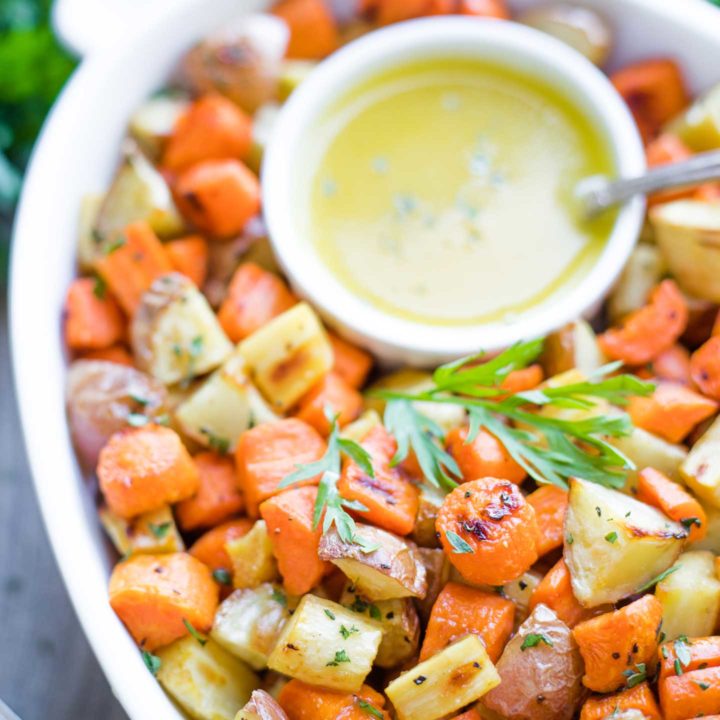
Roasted Root Vegetables with Honey-Dijon Drizzle
These Roasted Root Vegetables are so delicious, either on their own ... or with the addictive Honey-Dijon Drizzle! A super-easy side dish any night (mix it right on the sheet pan!), and especially perfect with Thanksgiving turkey, Christmas roast, and Easter ham!
• Ready in 30 Minutes or Less • Includes Make-Ahead Steps • Vegetarian • Gluten Free •
Ingredients
Vegetables
- 16 ounces peeled carrots, cut into 1/2" dice to equal about 3 cups
- 8 ounces lightly peeled parsnips, cut into 1/2" dice to equal about 1 1/2 cups
- 8 ounces red potatoes (NOT peeled), cut into 1/2" dice to equal about 1 1/2 cups
- 4 teaspoons extra virgin olive oil
- 1/2 teaspoon kosher salt
- 1/4 teaspoon black pepper
Drizzle
- 1 1/2 tablespoons apple cider vinegar
- 1 tablespoon extra virgin olive oil
- 1 tablespoon honey
- 1 tablespoon smooth dijon mustard
- 1/16 teaspoon kosher salt
- optional: chopped parsley for garnish
Instructions
- Preheat oven to 475°F. Line a large baking sheet with parchment paper.
- Toss vegetables with 4 teaspoons oil, 1/2 teaspoon salt, and 1/4 teaspoon black pepper. Make sure that the vegetables are evenly coated with oil, and that the seasonings are distributed throughout. (You can do this in a bowl, or directly on the parchment-lined baking sheet.)
- Spread the vegetables out on the baking sheet so they aren't piled on top of each other. (If you have a smaller baking sheet and the vegetables are crowded, it's best to grab a second baking sheet, rather than piling the veggies up.)
- Roast the vegetables for about 12 minutes. Stir vegetables and continue roasting for 8-10 minutes longer, until the vegetables have toasty, browned, roasted spots but aren't burned.
- While the vegetables are roasting, whisk together all ingredients for the Honey-Dijon Drizzle (vinegar, olive oil, honey, mustard, and salt).
- Serve vegetables warm, drizzled with Honey-Dijon sauce and sprinkled with a little chopped fresh parsley, if desired. (We like to pass the Honey-Dijon Drizzle at the table so each person can use the amount the like.)
Notes
Make-ahead steps: Both parsnips and potatoes brown after they're peeled or cut, so I don't recommend dicing either of them in advance. However, you can peel and dice the carrots even a day or two ahead of time, and store in the refrigerator. Also, you can make the drizzle in advance. While it's fine on the counter for a couple of hours, if you're making it further ahead, I recommend refrigerating it. Bring to room temperature and re-whisk (if needed) before serving.
Making a more "vinegary" drizzle: If you like your dressing with a slightly more vinegary kick (as my son, Ty, does), then use 2 tablespoons apple cider vinegar and also increase the extra virgin olive oil to 2 tablespoons.
Nutrition Information:
Yield: 8 servings Serving Size: 1/2 cupAmount Per Serving: Calories: 110Total Fat: 4gSaturated Fat: 1gTrans Fat: 0gUnsaturated Fat: 3gCholesterol: 0mgSodium: 238mgCarbohydrates: 17gFiber: 3gSugar: 6gProtein: 2g
Nutrition information should be considered an estimate only, and may vary depending on your choice of ingredients or preparation. No guarantees are made regarding allergies or dietary needs. Always consult a physician or dietician for specific advice and questions.

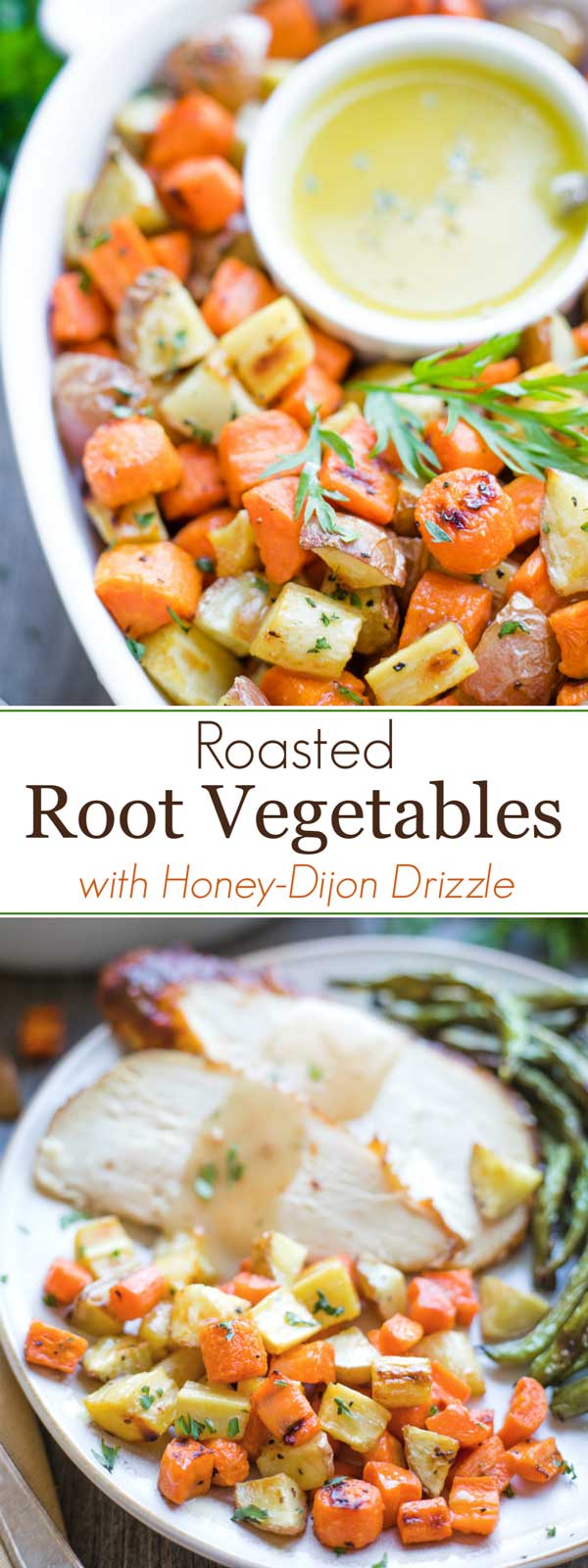
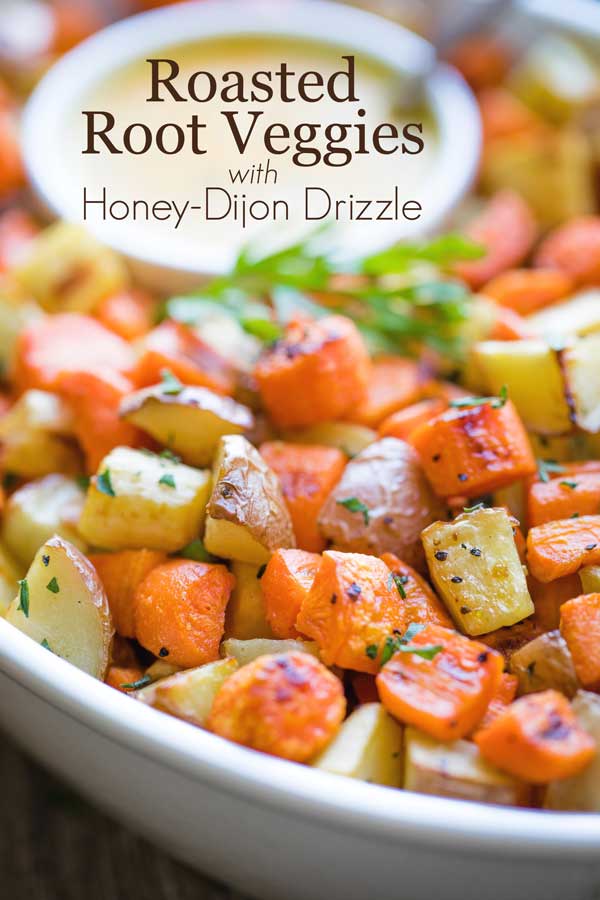
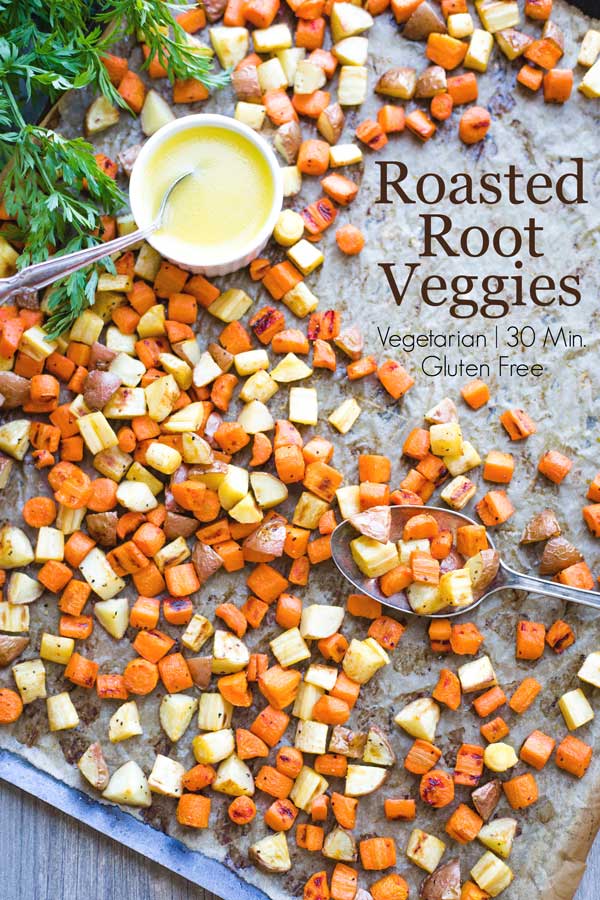
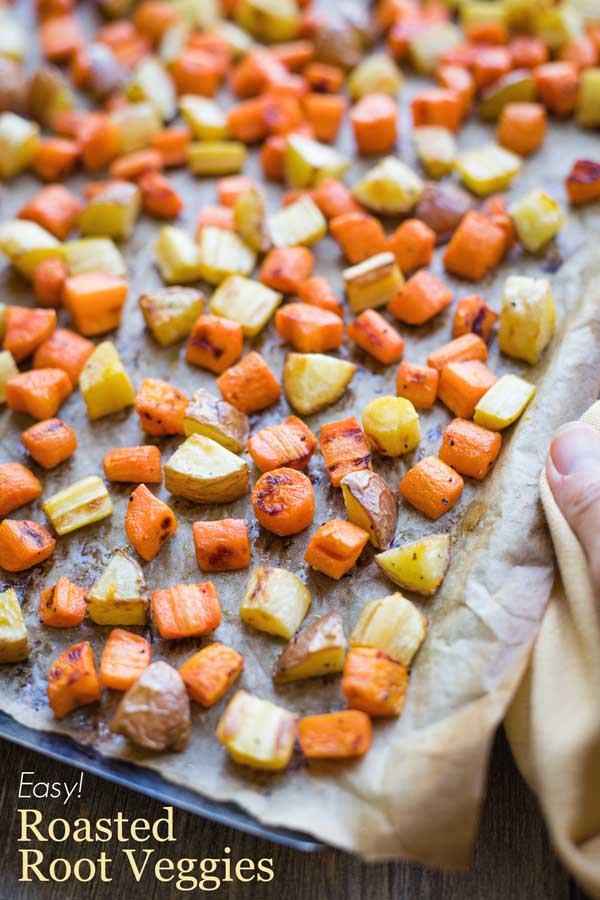
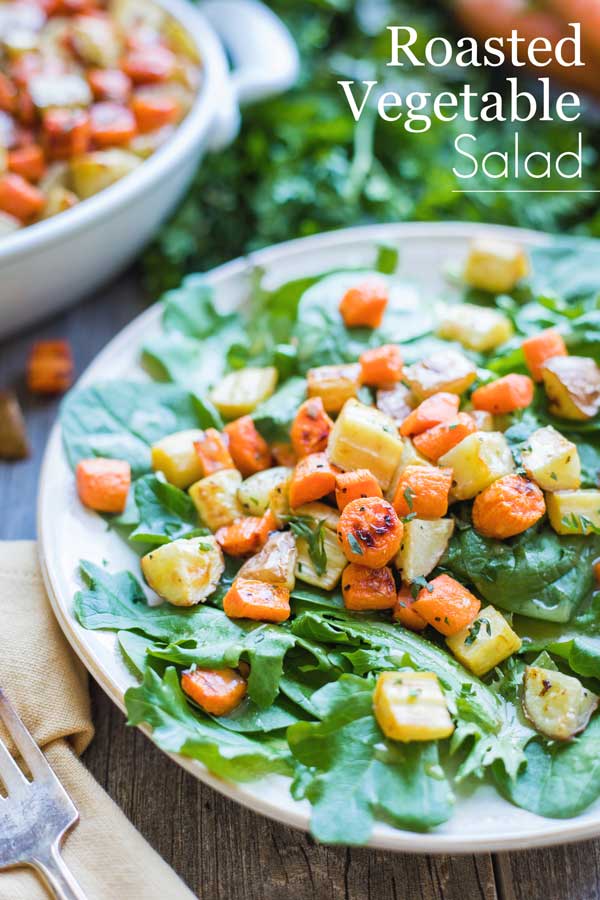
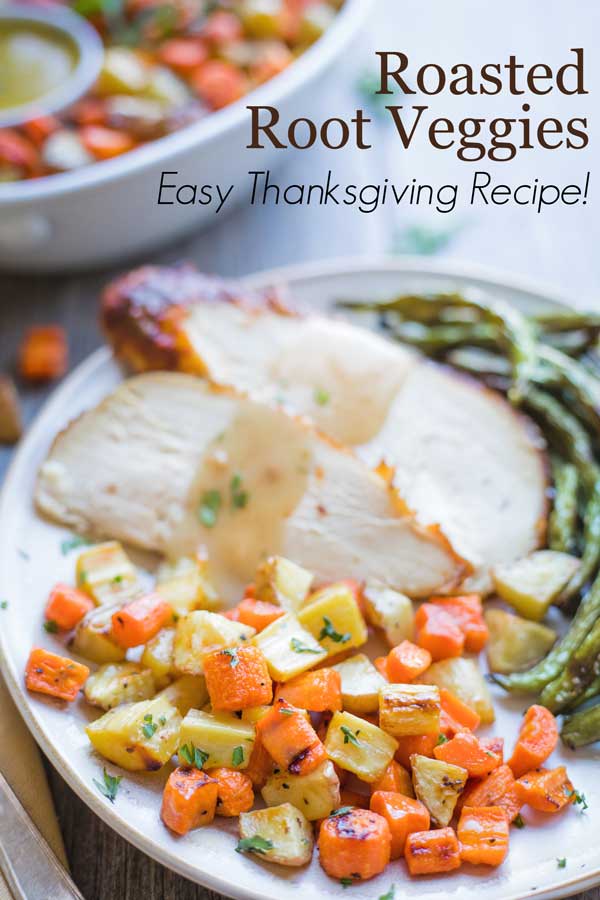
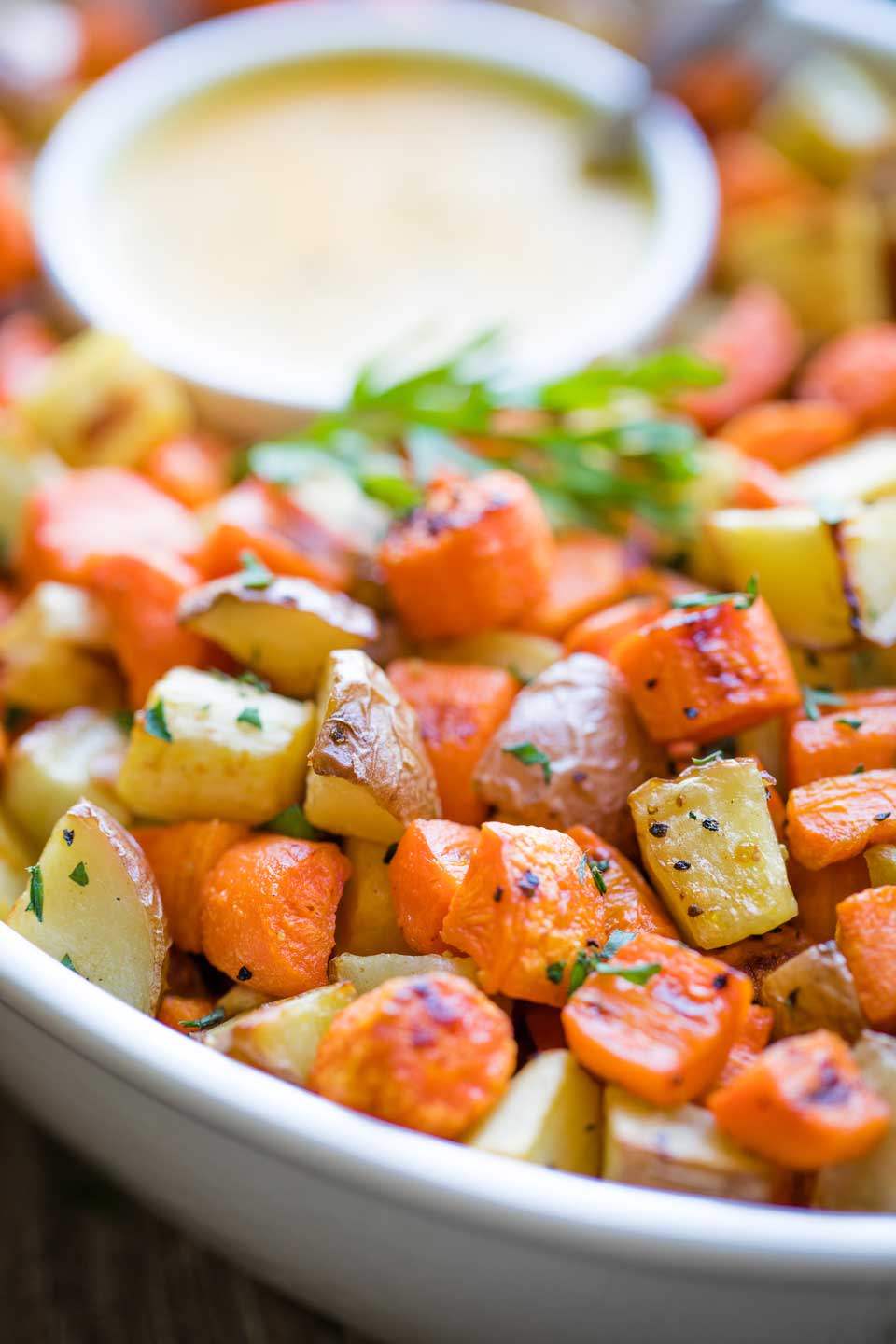
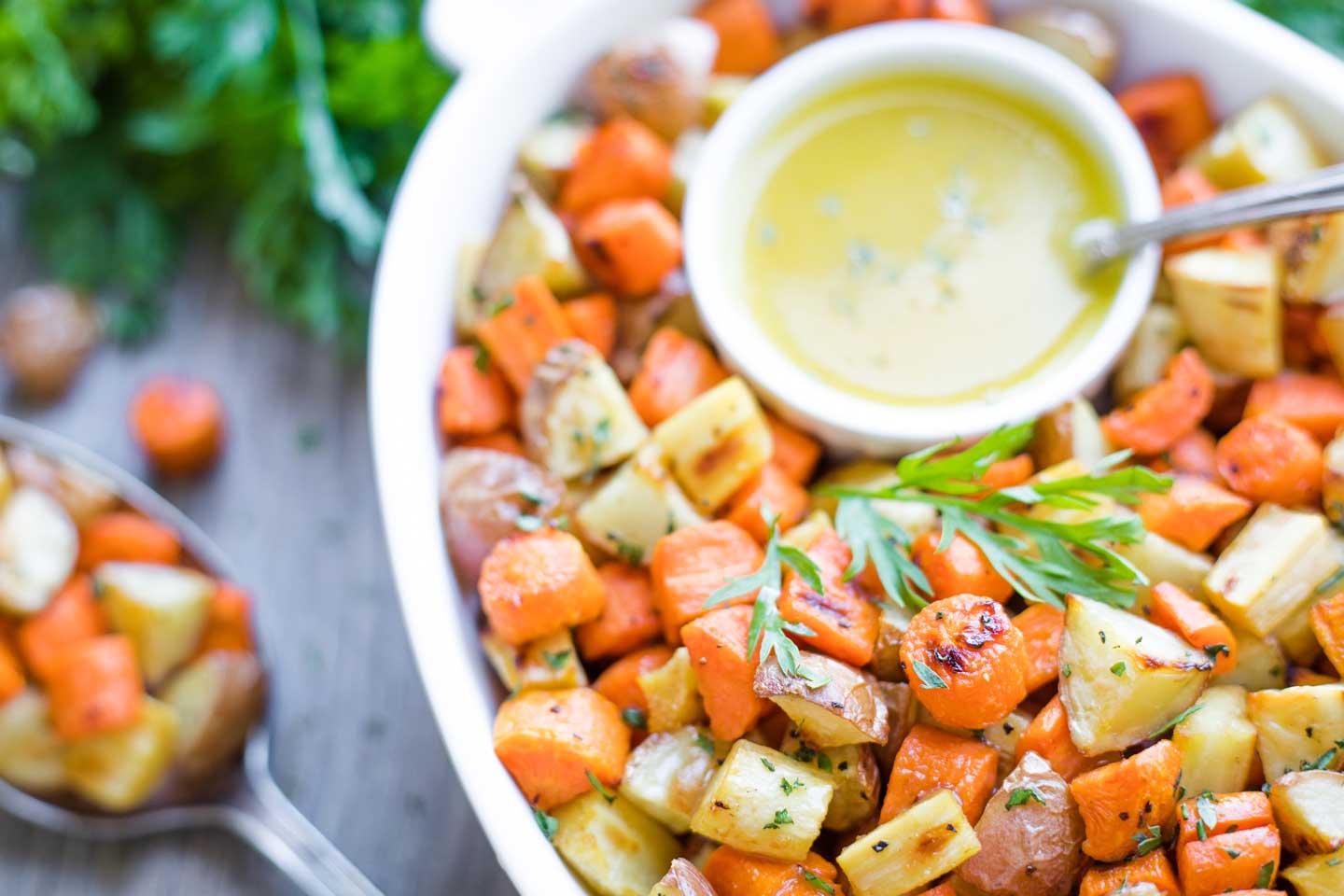
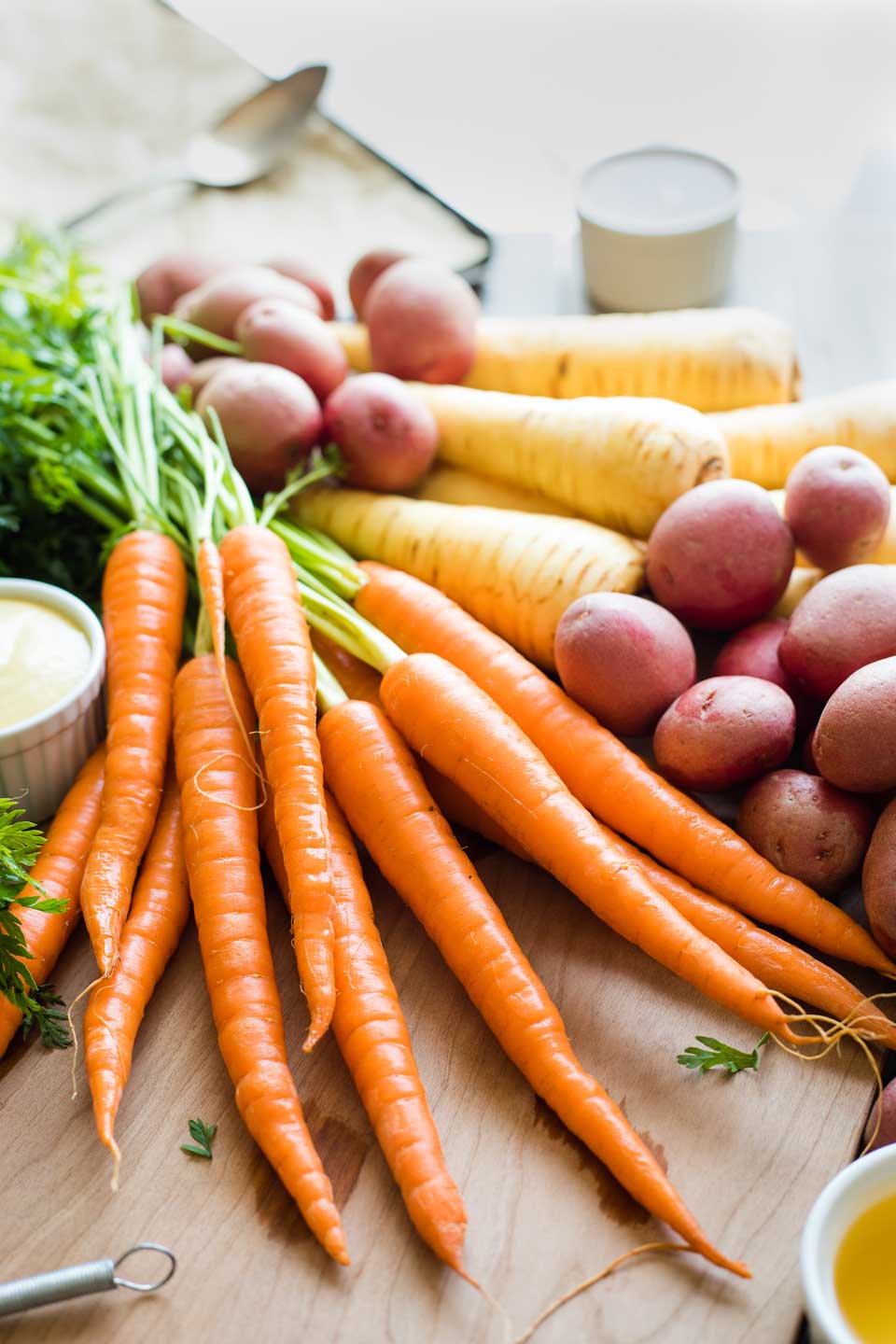
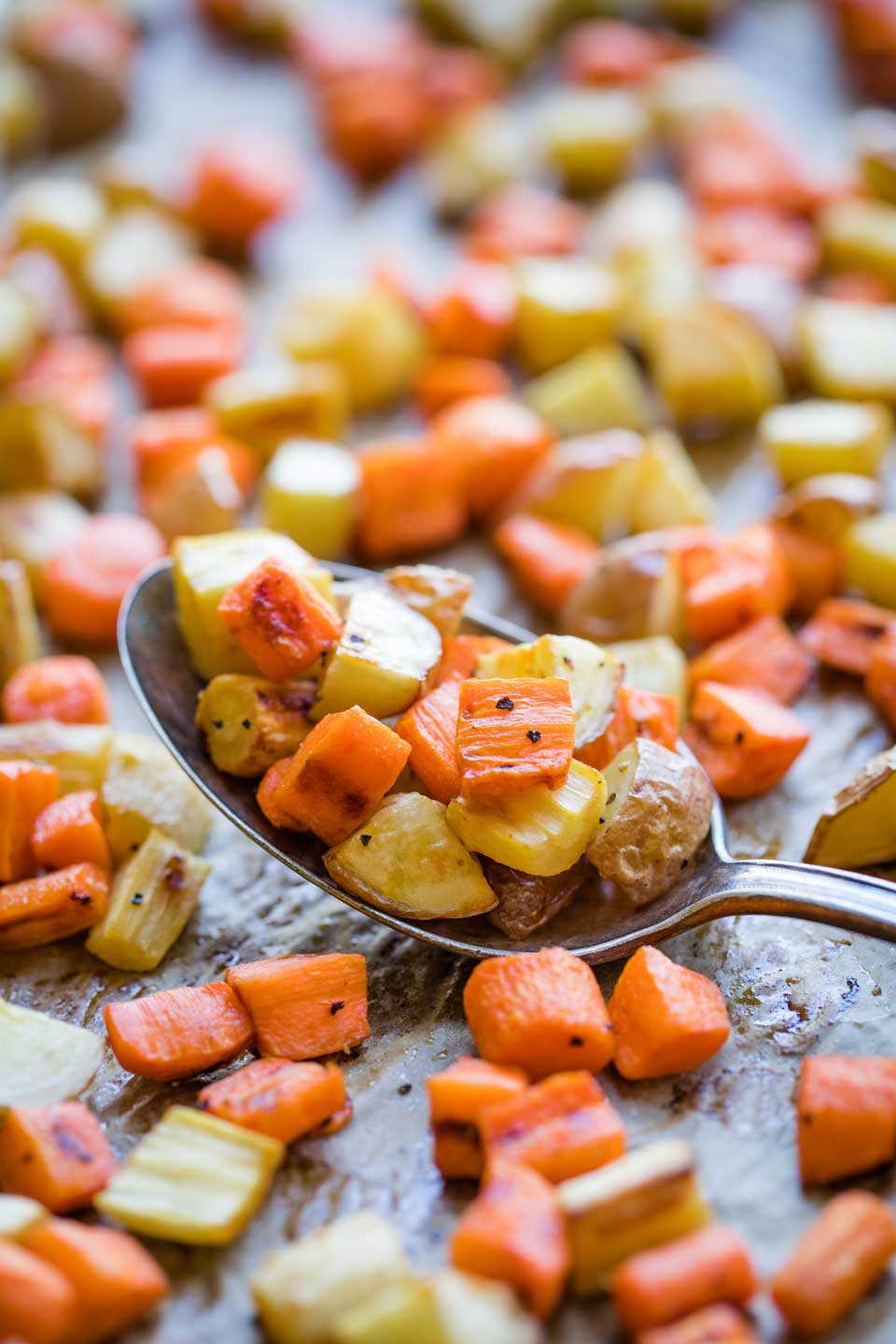

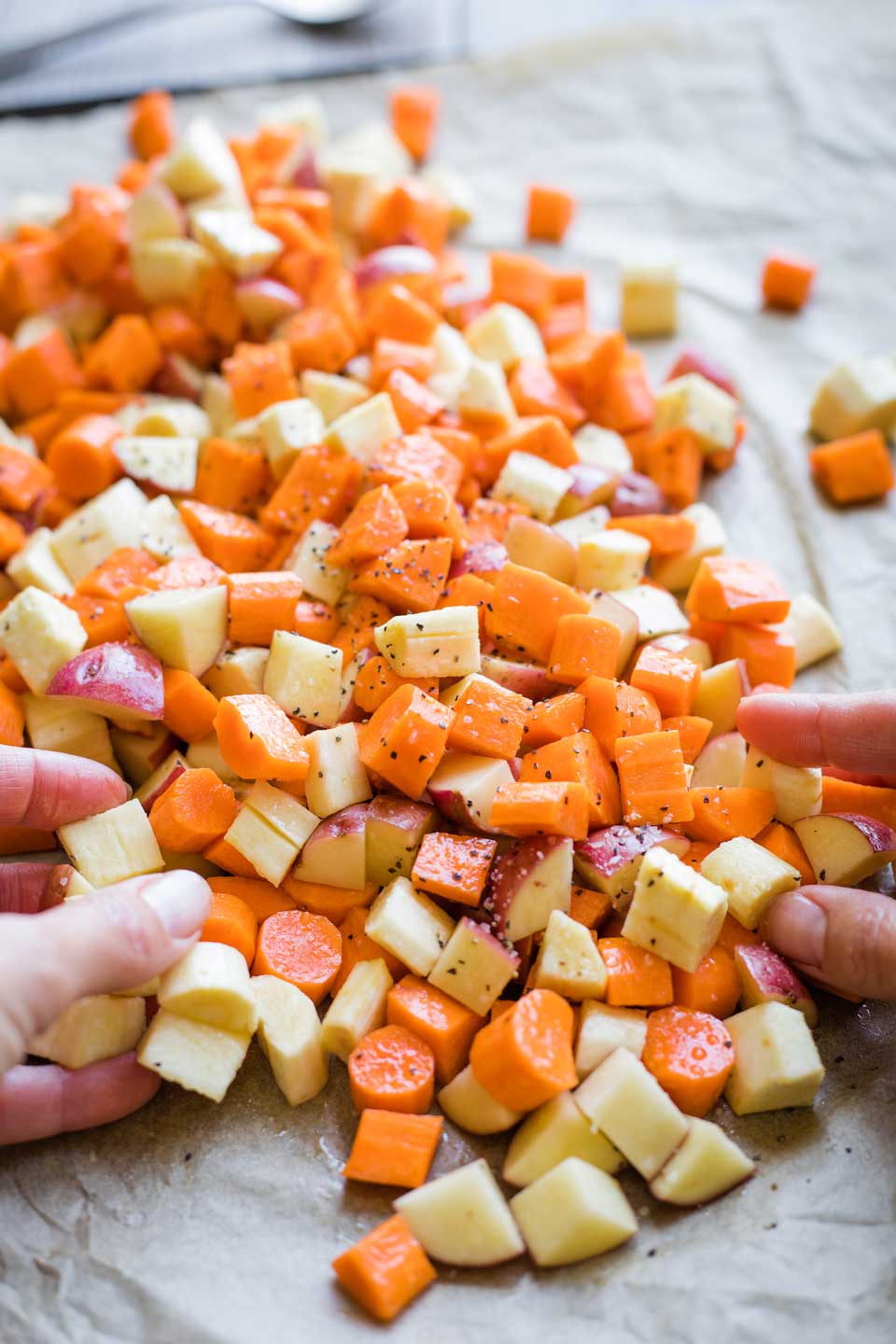
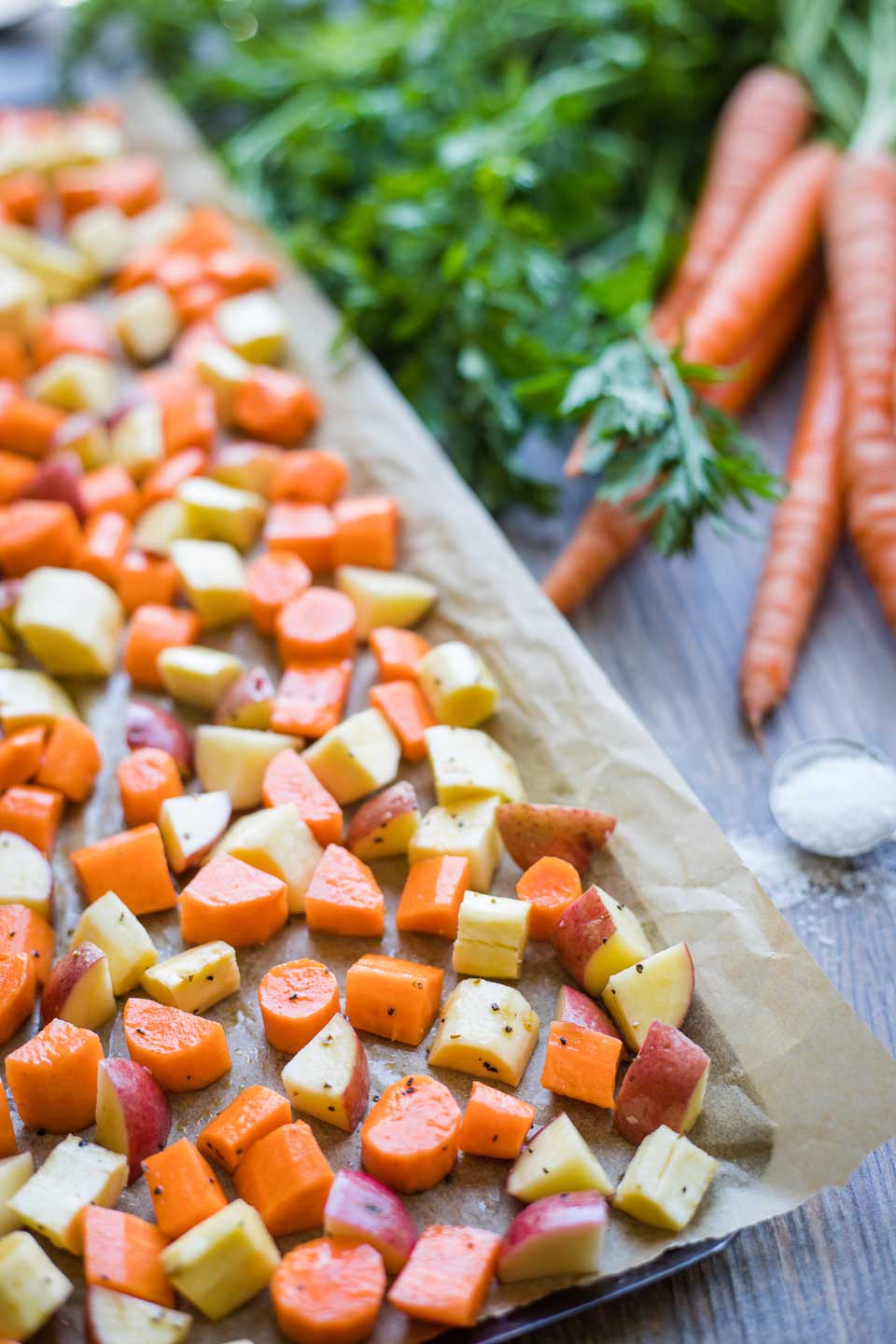
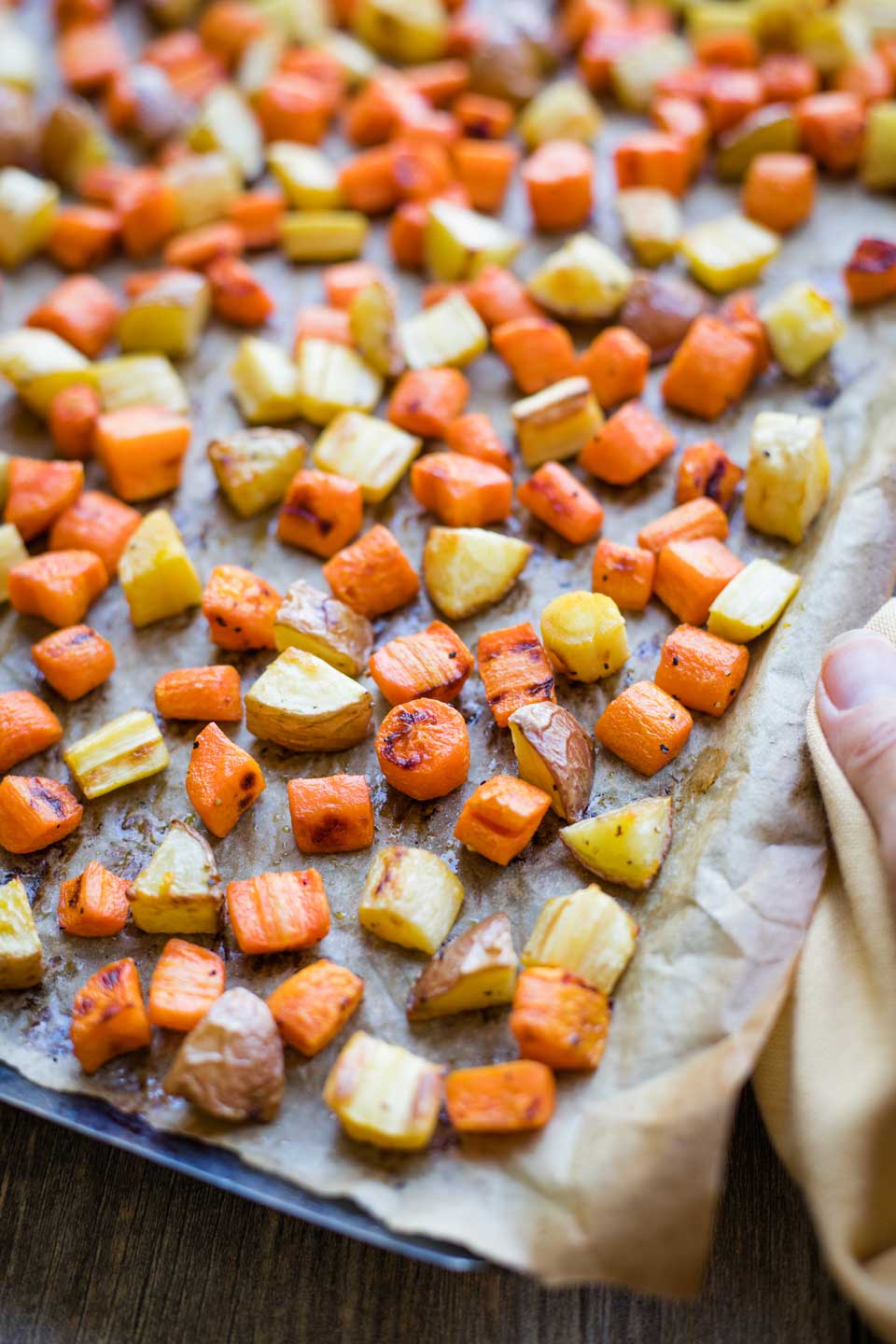
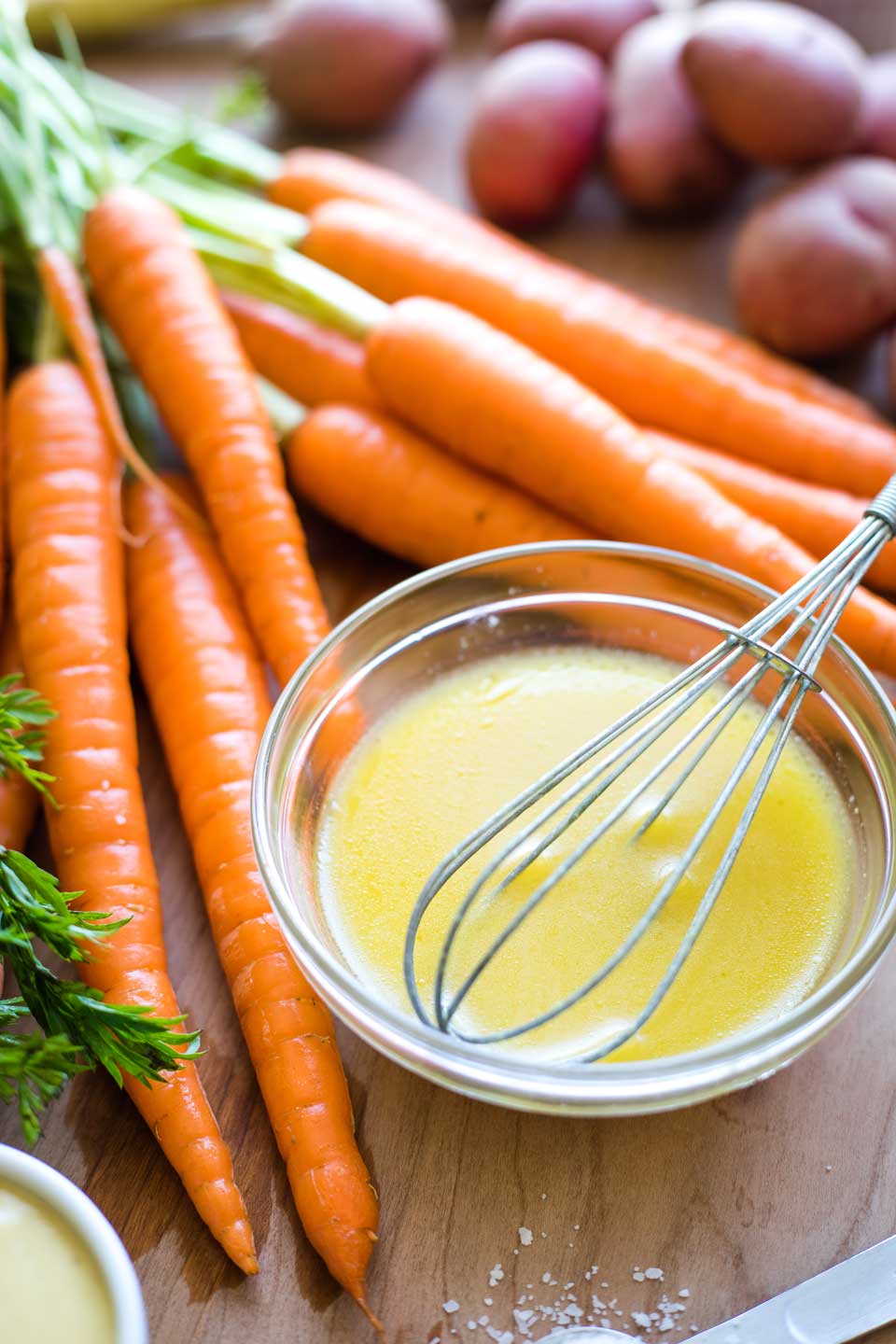
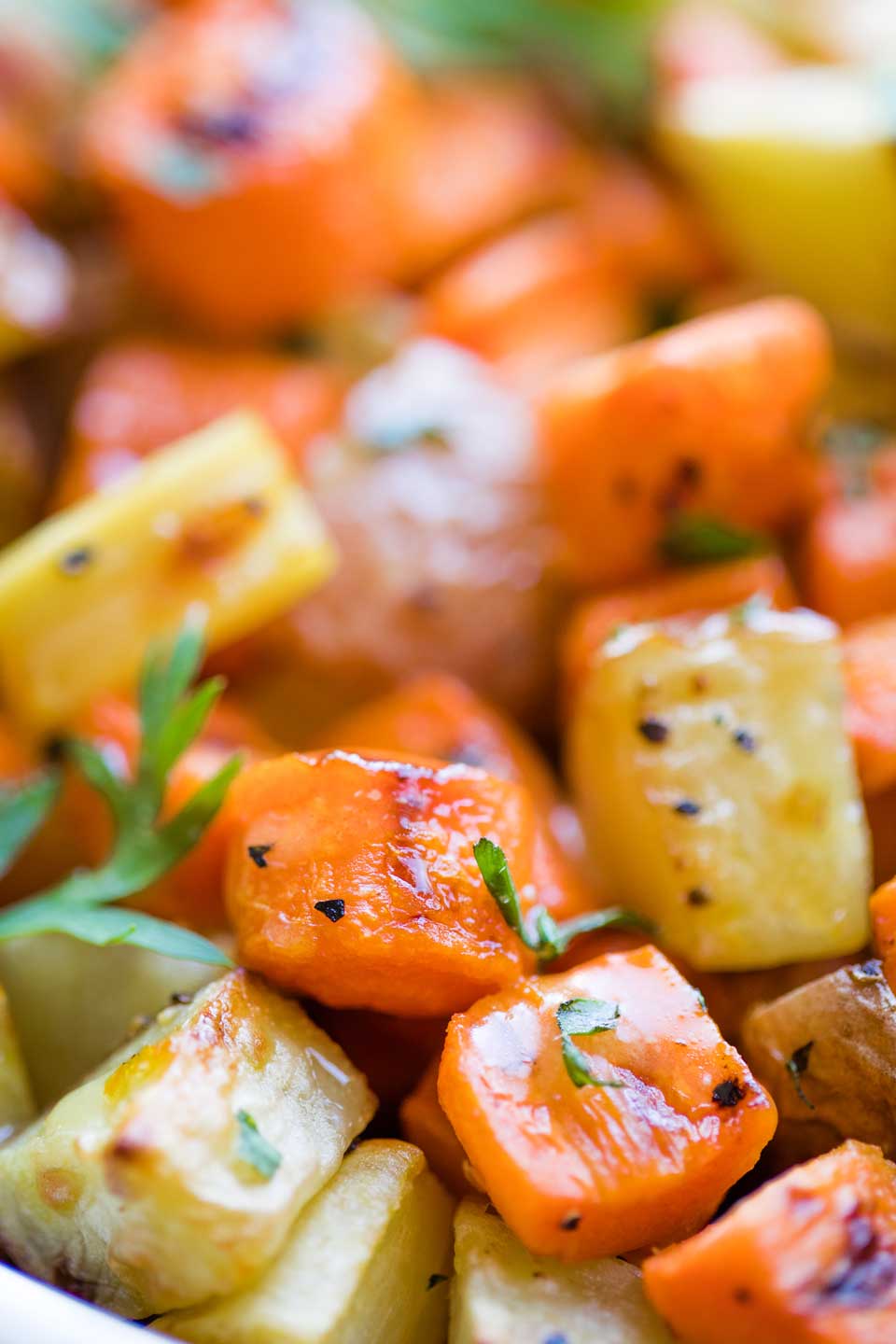
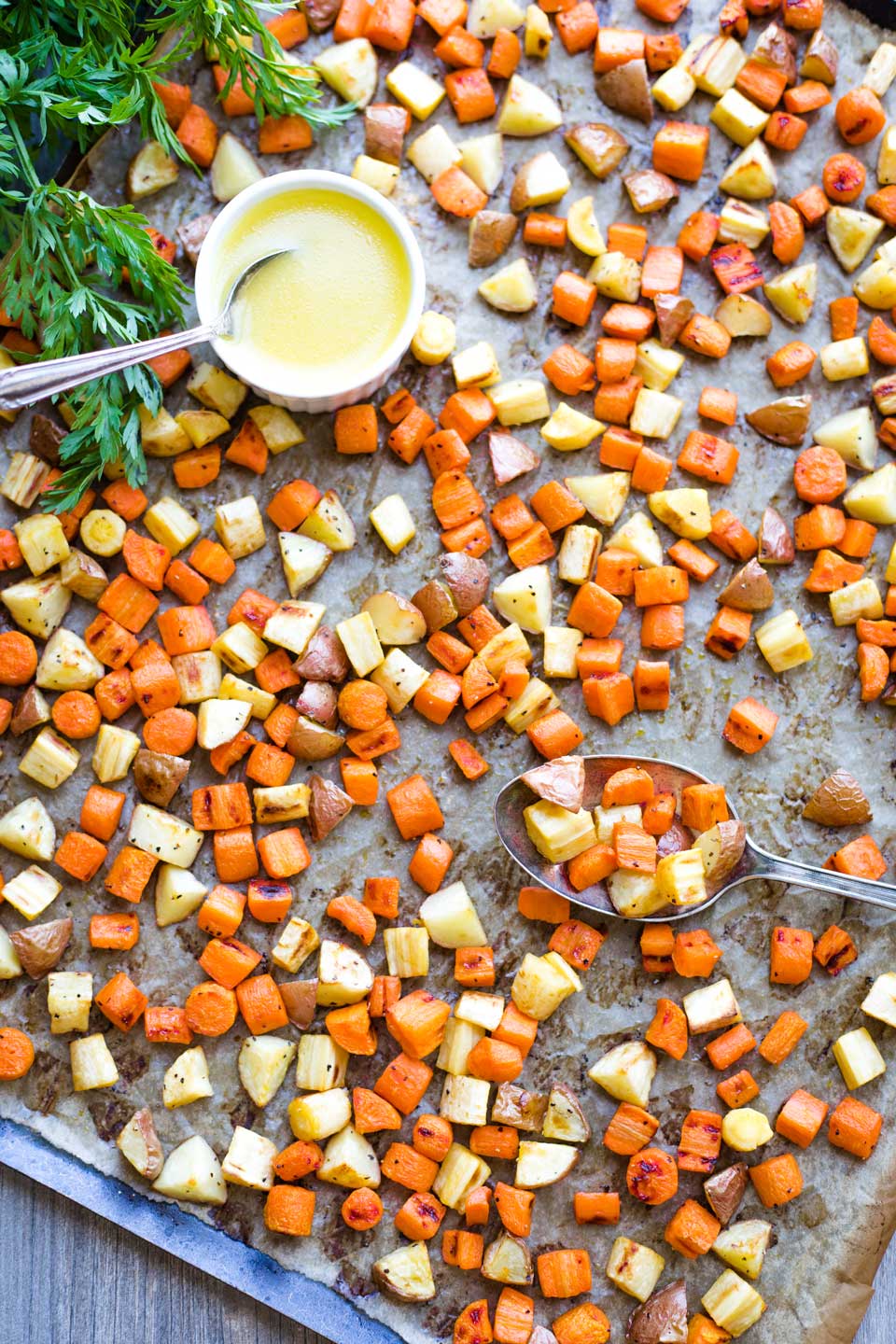
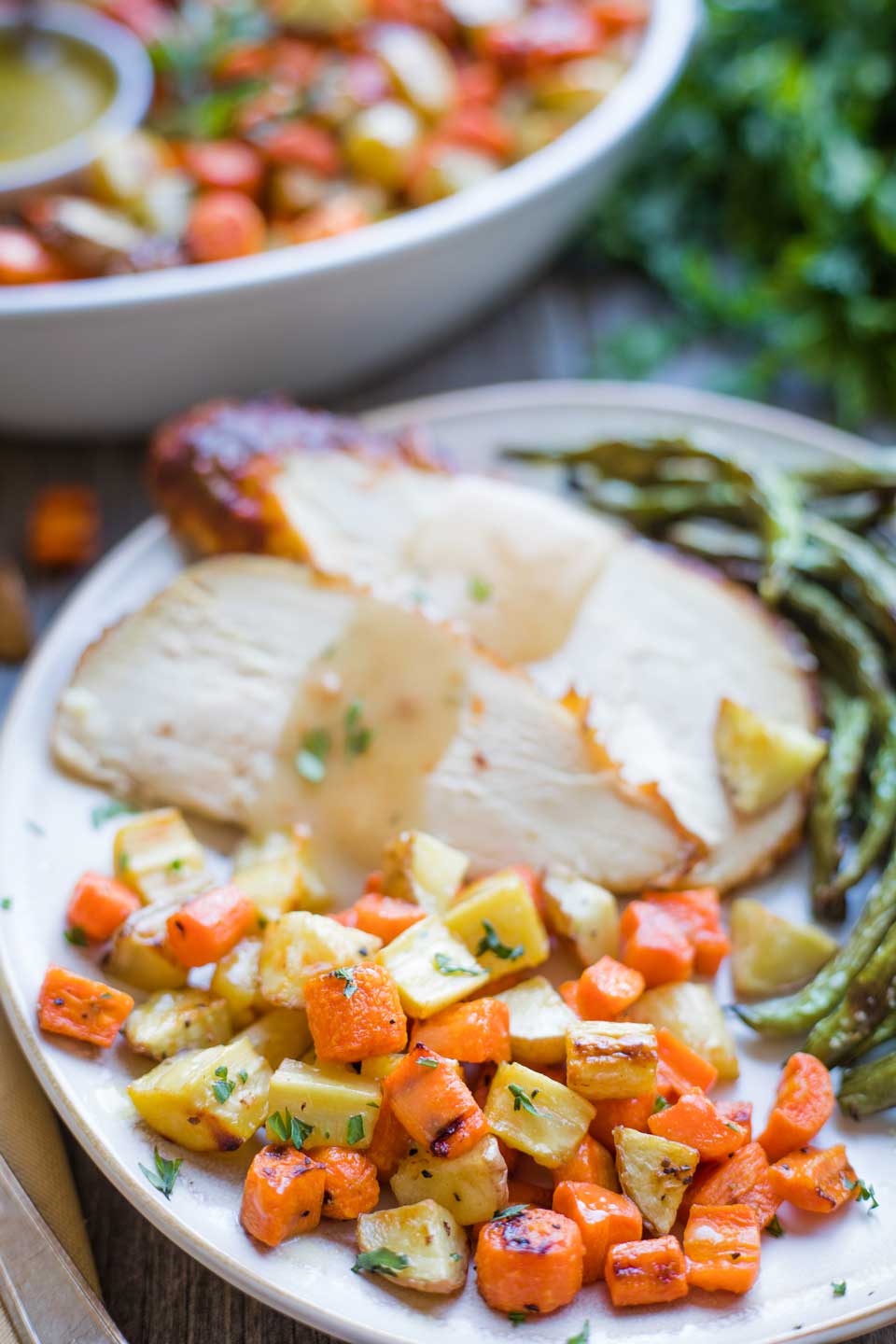
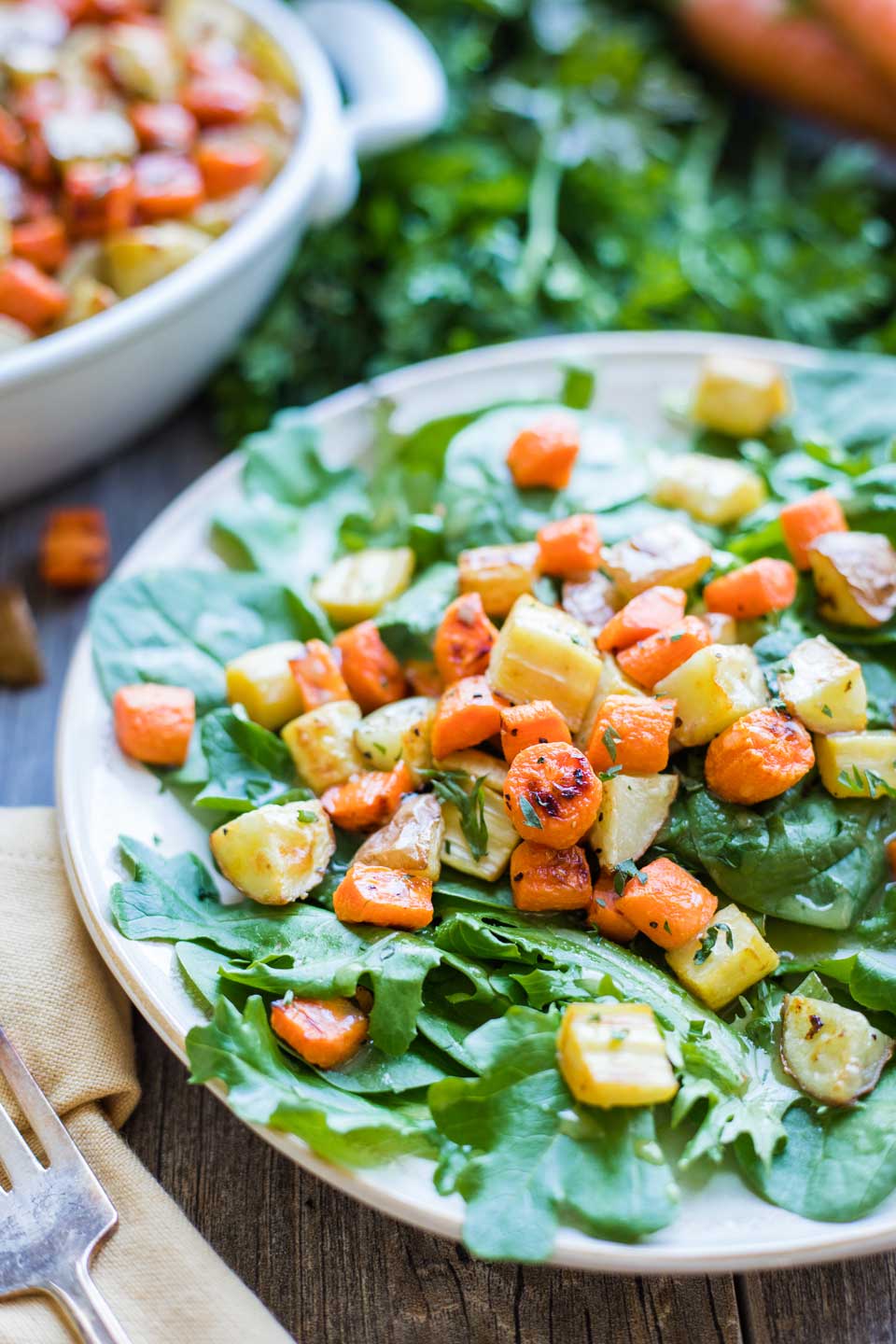
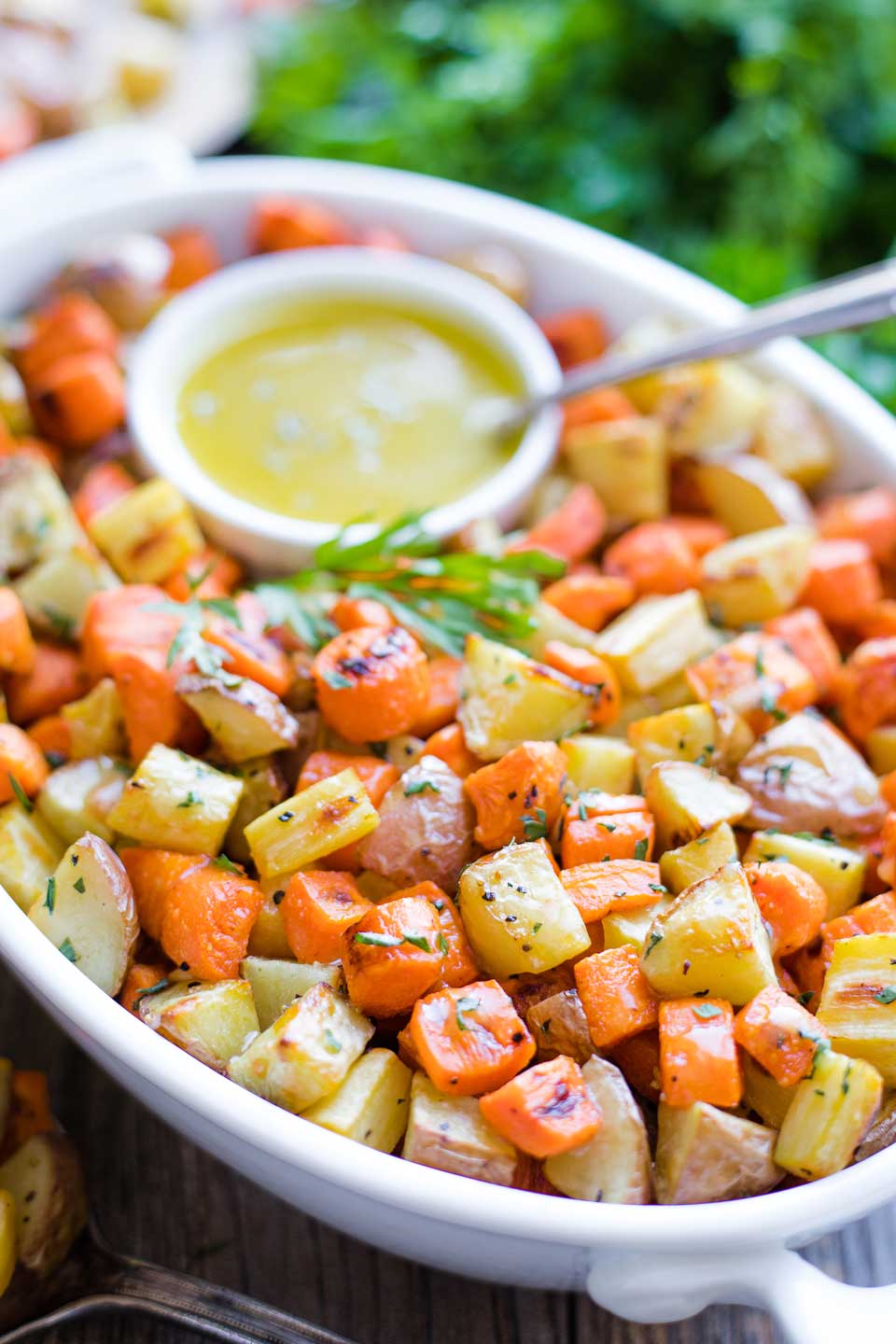
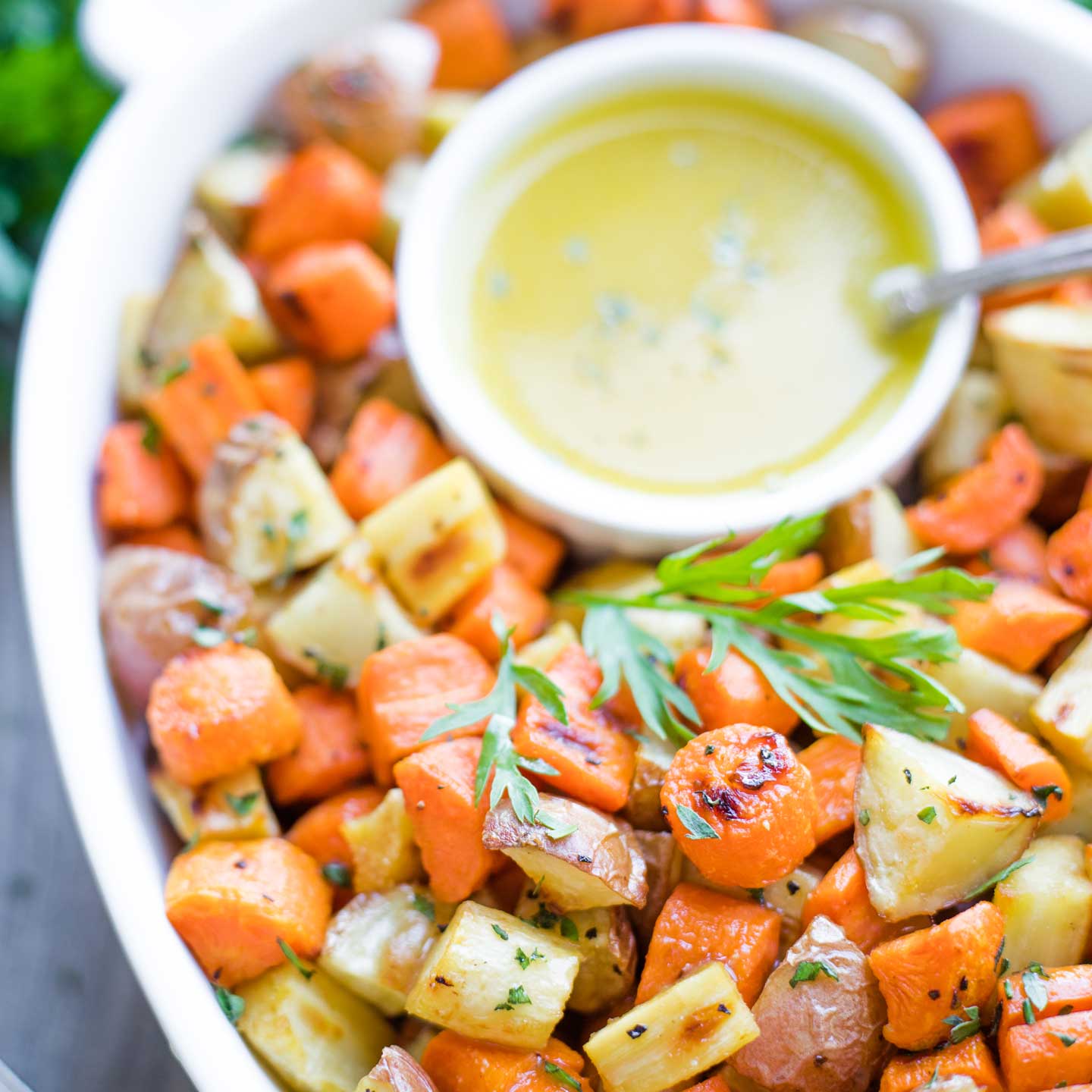
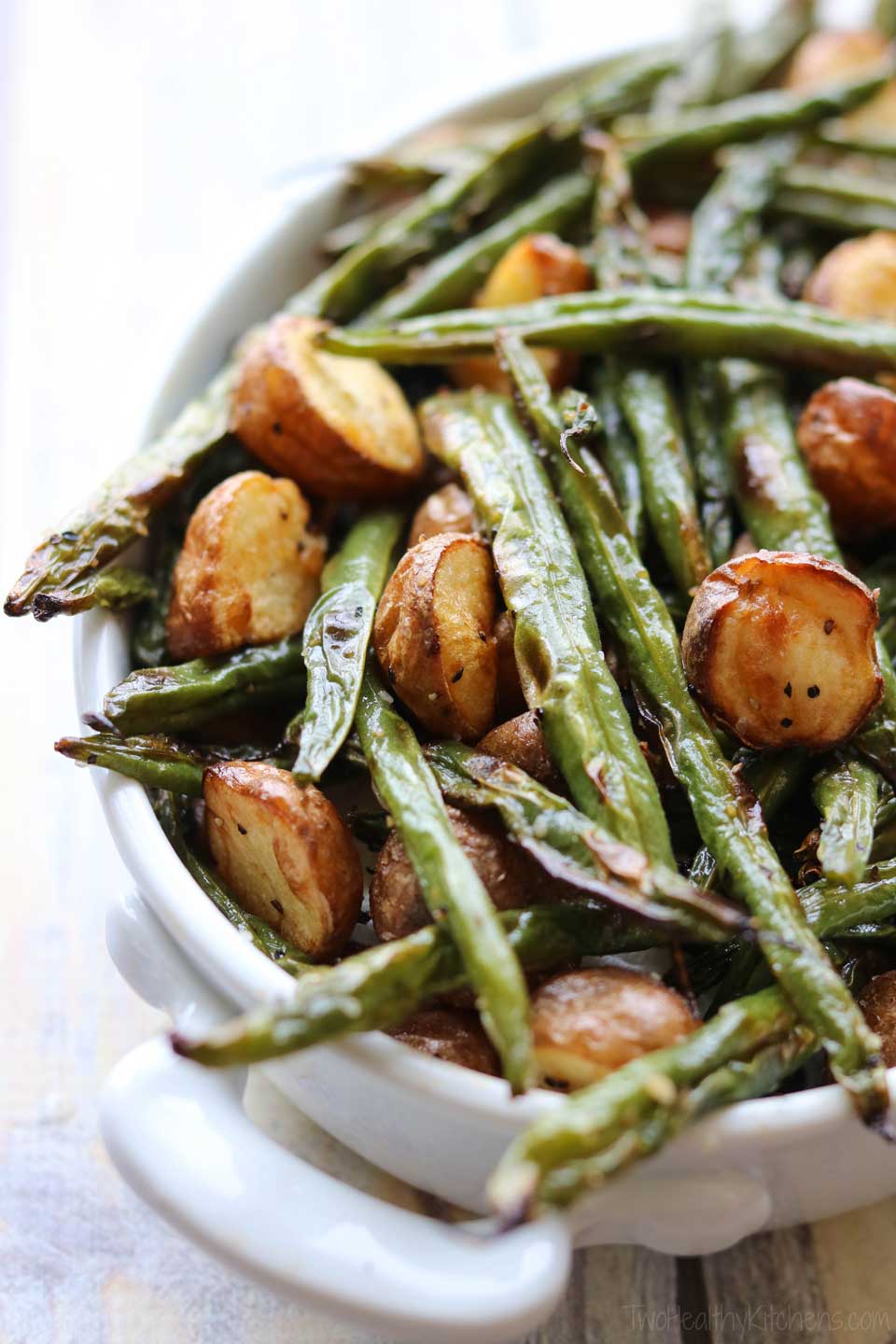
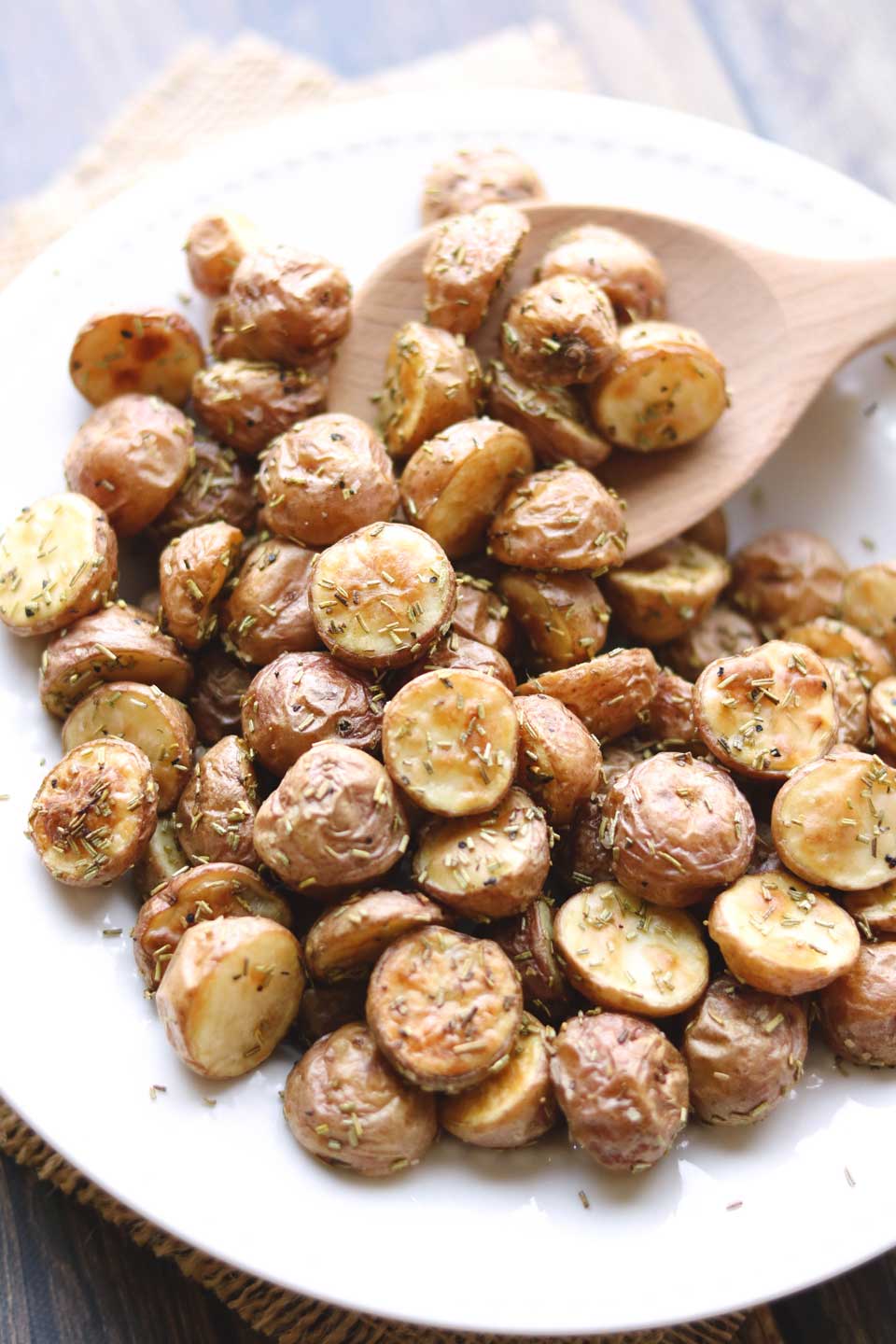
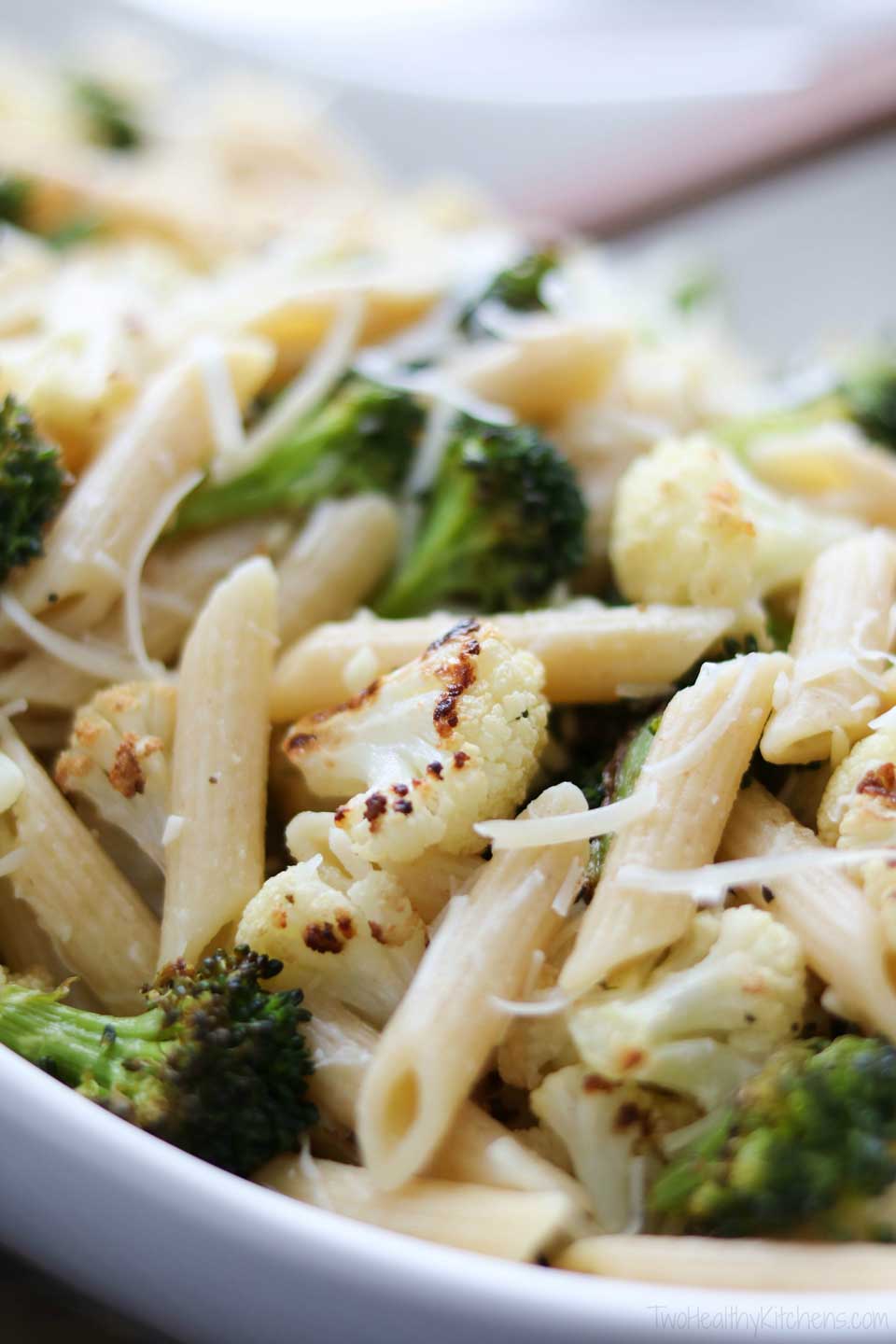
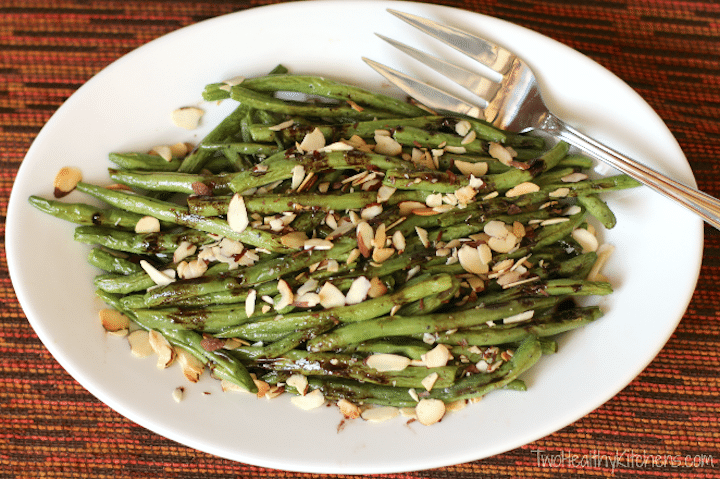
Can I roast them the night before and reheat before serving or do they become soggy?
Hi, Tina! I typically find that, depending on how you reheat them, most roasted vegetables like these do reheat pretty well. Definitely don’t add the drizzle until you’re going to serve them, though – if they hang out in the fridge with the drizzle already on them, that certainly could make them a bit soggy. ~Shelley
Love roasted vegetables. This roasted root vegetables is so simple but so amazing! I could eat it as it is! YUM
That’s the beauty of it — it’s so simple you won’t have any trouble making it, so healthy you won’t feel guilty about eating it, and so yummy you’ll want to eat it all the time!
~Amy
This is a great idea! I love roasted vegetables and this is a great way to make them easy with delicious flavor!
Hi, Veronika! I’m so glad you like this recipe — and I definitely agree with you, there!
~Amy
I absolutely agree with you – roasting veggies makes them so flavorful. It’s like taking them to a whole new level of culinary experience. My favorite side to go with meat dishes. Yum!
This is one of my favorite side dishes, too — it goes so well with so many dishes!
~Amy
I love roasted vegetables, this roasted root vegetable is a great side dish and the dressing on top just makes it that much better.
Hi, Sharon! I’m so glad you like this recipe — I’ve gotta say, the drizzle really does make it pop! 🙂
~Amy